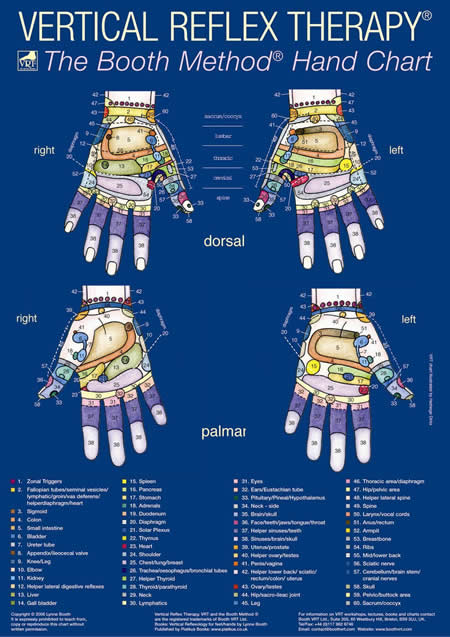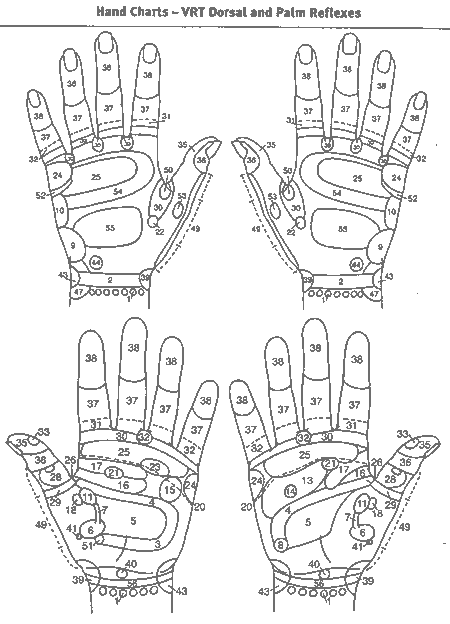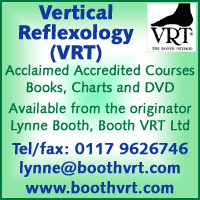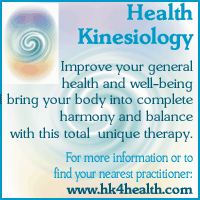Positive Health Online
Your Country

Vertical Reflexology for Hands and Feet: Do not neglect the beneficial role of hand reflexology
listed in reflexology, originally published in issue 169 - April 2010
The familiar position for a Reflexology session is to lie back in a chair, or on a couch, while the Reflexologist gently and precisely works pressure points on the feet. Hand Reflexology has equal benefits, but is less well known. This treatment is a pleasurable way to relax and receive therapeutic help at the same time, but Reflexology can even offer more when the hands are worked either passively or in a weight-bearing position. Even small children can be taught simple hand techniques to help them sleep or, for example, to aid their breathing if they are asthmatic. Reflexology is a profoundly effective, non-invasive, therapy which is used extensively in private practice as well as in some hospitals, nursing homes, sports clubs and the workplace.

This ancient science states that all the glands, organs and parts of the body have a corresponding reflex point in the feet and hands. A Reflexologist is trained to detect tiny deposits and tensions that block the nerve and blood supplies to the body. By exerting pressure, using fingers and thumbs, the circulation is improved, and energy and homeostasis (balance) is restored to the body's cells. If the body is in a state of tension, due to ill health, disease or stress, this imbalance is registered in the feet and hands.
I have increasingly incorporated hand reflexology into my repertoire with very rewarding results. Some Reflexologists choose not to work the hands; my aim is to encourage therapists to expand their repertoire and for clients to be taught to practise simple self-help hand techniques to alleviate common ailments. Full hand reflexology treatments are often very appropriate for older people with multiple pathologies, but I encourage all practitioners to mix-and-match hand and foot techniques within the same standard treatment sessions.
What is Vertical Reflex Therapy (VRT)?
Vertical Reflex Therapy (VRT), also known as Vertical Reflexology, is a technique I developed where the weight-bearing hands or standing feet are briefly worked for up to 5 minutes on the dorsal (top) area at the beginning and end of a classical reflexology treatment.[1] It can also be used as part of shortened 20 minute sessions. In VRT I have mapped out the familiar plantar (sole) reflexes on the dorsum of the hands or feet, giving the reflexes a three-dimensional approach. A plausible and anatomical explanation for VRT's efficacy is that, anatomically, the nerves on the passive hands and feet are naturally desensitized but, as soon as a hand or foot become weight-bearing, the nerves then become sensitized and the energetic response is stronger. 
I believe that hand reflexology has never been given the prominence it deserves, and yet it is just as effective as foot reflexology.[2] However, the sensation or responses from the hand reflexes are slightly delayed and may take a few seconds longer to be experienced. Fortunately, many reflexology text books and college syllabus' now encourage students to work the hands; Kristine Walker has been a pioneer in this field and describes some of the highly effective techniques in her book Hand Reflexology: a student text book[3] as does Vertical Reflexology for Hands.[2]
Reasons for using VRT/Hand Reflexology
Self – help homework for clients on the passive and weight-bearing hands can be highly effective between treatments to help accelerate the healing response. A VRT practitioner will often give their client a hand chart marked with 3-4 specific key reflexes that are stimulated twice a day for only 1-2 minutes in total. A professional Championship footballer followed these simple instructions and stated "VRT is great for accelerating recovery from various sports injuries. I've also learnt lots of beneficial self-help VRT techniques to use in between treatments. It has helped me immensely to reach my peak, at every level." In 2002 a small study in the workplace on VRT and Hands[4] reported an 80% improvement in some ailments in only four weeks and I am convinced that these impressive results came about because the clients briefly worked their own hands each day. Hand reflexology can be discreetly used in many different settings and employers of large multinational companies are inviting reflexologists in to treat their staff as it is a pragmatic decision to benefit the individual and collectively help the company.
Many older people have foot problems ranging from lymphedema, arthritis, skin disease or general immobility that makes access to the feet difficult or impossible. The hands are not only far more accessible, but they have many positive factors that make them easier to treat than the feet. For example, the sinus reflexes cover a wider area on the fingers although the spinal hand reflexes are compressed compared to the foot, but can be stimulated by precise work on the accessible smaller bony medial side of the hand. Working the hands, rather than feet, can appear more intimate, so personal space must always be respected, and I make a point of letting a client know I am about to take their hand, and I talk them through what I will be doing as I start to work. This puts the touch into a therapeutic mode and creates a natural professional 'distance' between the Reflexologist and client.
Contraindications
There is no difference between VRT and classical reflexology in terms of contraindications; the hands and feet respond equally well.. However, some additional, commonsense 'rules' do apply when applying VRT, i.e. if the client is frail, prone to dizziness or unsteady on their feet, the therapist should treat the client's semi-weight-bearing feet (or hands pressed on a book or tray) while they remain seated. Conclusion
Hand reflexology is the obvious choice for particular client groups and conditions, and is especially relevant when giving a person self-help instructions. Many people, who do not like their feet touched, may be willing to receive hand reflexology; this can widen the client base as well as allowing discreet first aid reflexology in situations where the removal of shoes would be inappropriate. Hand Reflexology for Asthma and Sleep Problems
An eight year old girl had a VRT/reflexology treatment for a chronic asthmatic condition that caused her to miss some games and gym lessons at school. She was a nervous child who often could not get to sleep at night and lay awake worrying. She had hand and foot VRT/Reflexology and I connected the lung and bronchial dorsal reflexes as the fleshy reflex area felt very tender and gritty to the touch, suggesting an imbalance. I taught her to work her own hands if she woke in the night by using a gentle rocking movement of the solar plexus/diaphragm reflexes called Diaphragm Rocking. Over a period of weeks she began to sleep better and experienced less asthmatic wheezing. She also learnt how to press her hand firmly down on a desk at the first sign of a wheeze to work the bronchial and lung reflexes near the webbing between the thumb and index finger. She felt that this action sometimes helped to avert a very mild asthma attack and on several occasions, following this method, she did not need to use her inhaler, and her breathing naturally regulated. References
Books 1. Booth, Lynne. Vertical Reflexology. Publ Piatkus Books, London.. ISBN: 0-7499-2132-3. 2000.
2. Booth, Lynne. Vertical Reflexology for Hands. Publ Piatkus Books, London. ISBN: 0-7499-2319-9. 2003.
3. Kristine Walker. Hand Reflexology : a text book for students. Quay Books, a division of Mark Allen Publishing Ltd. ISBN-13: 978-1856422086. 2002.
Short Study
4 Booth, Lynne. Small study on VRT and reflexology in the workplace study, July 2002.
Comments:
-
No Article Comments available

